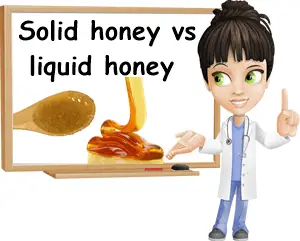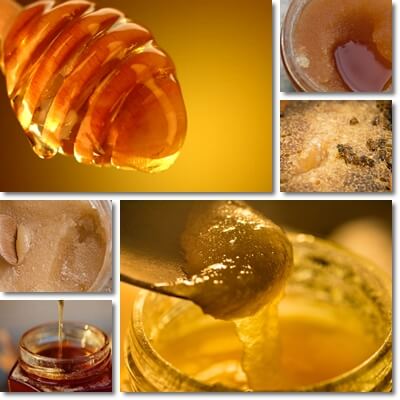The real difference between crystallized and liquid honey is they are a solid and liquid version of the same natural product: honey. What this means is that one has a rougher, grainier texture and is harder to scoop out of the jar, while the other has a smooth texture and is easier to spread on bread. Both are equally nutritious, providing the same essential nutrients and antioxidants, and the same range of health benefits. The difference in consistency is an aesthetic issue and doesn’t impact the quality of the honey.
Is crystallized honey spoilt?
Crystallized honey being spoiled is one of the biggest myths about honey, along with honey being a better substitute than sugar for baking (no, it’s not a good idea to substitute it for sugar, despite it being healthier). Crystallized honey is not spoilt. It’s not old, it’s not bad or expired. It’s just granulated or solid, which are just synonyms for crystallized. It’s actually good honey and, often times, a crystallized honey has a higher chance of being pure and unadulterated. Because real honey crystallizes naturally (see more myths and facts about honey).

Why does honey crystallize?
What makes honey crystallize is the simple sugar glucose which is the first to start forming crystals, setting the tone for the crystallization of the entire honey. One sugar crystal is enough to build on and crystallize an entire jar or batch of honey. The average sugar content in raw honey is 80-82 g, mostly fructose and glucose, two simple sugars. The higher the glucose content in a honey, the faster the crystallization. The higher the fructose content, the slower the crystallization. The fructose-glucose ratio in a honey is determined primarily by the floral source, that is, the nectar of the flowering plant sourced by bees.
Should honey crystallize?
Yes, it should. Honey crystallizes naturally. The process occurs spontaneously in all honeys, although the crystallization time is different depending on the variety. For example, varieties of honey with a high fructose to glucose ratio, such as sage and acacia honey crystallize very slowly, often upward of 1 year (the more fructose relative to glucose, the longer the honey stays liquid).
In contrast, varieties with a higher glucose to fructose ratio, such as sunflower and rapeseed honey, crystallize quickly, in as little as 3-4 weeks. Some varieties may take days to start crystallizing, while others years (which is why it’s said that some honeys never crystallize). How fast a honey crystallizes depends on the nectar source, storage conditions such as choice of packaging, temperature and whether the product is sealed or not, stirred or left to sit etc.
Honey crystallization facts:
- Crystallized honey is still honey – the only difference is it’s solidified, not liquid.
- Crystallized honey is not spoiled – it’s still good and perfectly safe to eat.
- Crystallized honey is not just sugar – it is more sugar than water (80% to 82% sugar and 20% to 13% water), but still not just sugar, even it may look like it because of the sugar crystals.
- Crystallized honey is just as good as liquid, retaining all the nutrients and biologically active compounds that make honey healthy. See the benefits of crystallized honey.
- How quickly or slowly a honey crystallizes does not affect its taste or beneficial properties.
- How quickly or slowly a honey crystallizes affects its texture – the faster the solidification, the finer the sugar crystals and the smoother the texture.
- Factors that promote crystallization: higher glucose and lower fructose content, higher water content, improper storage, presence of pollen particles, bees wax, propolis and other grains to build on, stirring or mixing, adding seed crystals (for example: a tablespoon of already crystallized honey), lack of pasteurization, certain temperatures (between 5-8 and 13-17 degrees Celsius).

Crystallized versus liquid honey
Here is how they compare:
- Crystallized honey has a higher chance of being real, raw and unadulterated vs liquid honey which is easier to adulterate (except for varieties known to crystallize slowly such as acacia or sage).
- Liquid honey is likely pasteurized and filtered to remove impurities, pollen grains, propolis particles, beeswax etc. vs honey that crystallizes which is likely raw and unfiltered (pollen grains, propolis, beeswax and other particles promote solidification).
- Crystallized honey has a rougher, grainier texture and is hard to scoop out of the jar vs liquid honey which is smooth and flows and is easily spreadable.
- Liquid honey is clear and vibrant, covering shades from light amber to reddish-brown and almost black. By comparison, solid honey is opaque, dull and lighter-colored than its liquid version, usually cream with muted amber undertones or dull brown in the case of dark-colored varieties.
- Despite its grainier, rougher, more solid consistency, crystallized honey is just as dense as liquid.
- Both liquid and crystallized honey are mostly sugar: 80 to 82% sugar and 20 to 13% water.
- The reason why it’s better to choose crystallized vs liquid honey is that you can always warm and liquefy crystallized honey. But it is harder to force crystallization of liquid honey.
- Both are meant to be eaten raw, not cooked. Cooking either one takes away from their benefits by destroying beneficial antimicrobial enzymes and vitamins.
- Both crystallized and liquid honey, assuming they are both raw and unadulterated, are equally healthy: they provide the same range of nutrients and the same range of health benefits. So know that your honey is still good to eat even if it crystallizes.
Crystallized honey fix
There is absolutely no reason to fix your crystallized honey, unless you want to spread it easier on bread. Turning crystallized honey back to liquid honey is fairly easy to do: you just place your jar of solidified honey in a pot of moderately hot water and wait until it slowly liquefies. Avoid boiling your honey as this will either burn it or cause the honey to lose its therapeutic properties, rendering it as nutritious as white table sugar.
If you’re looking how to prevent honey from crystallizing in the first place, know that you can’t really do that. What you can do is research the different varieties and choose one that is slow to crystallize, such as acacia. All honey is liquid when it’s freshly extracted from the comb, but ultimately solidifies because you can’t really keep honey from crystallizing since it’s a natural process. How quick it does crystallize depends on the variety and flower source which determines the fructose to glucose ratio.
